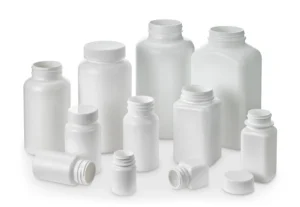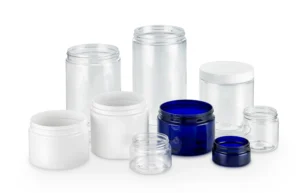The choice of plastic materials used for manufacturing end-user products plays a pivotal role in balancing environmental responsibility and meeting customer needs.
High-Density Polyethylene (HDPE) and Polyethylene Terephthalate (PET) stand out as some of the most common plastics found in this sector for products including packers, jars, bottles and canisters.
Are you wondering which plastic type is best for your product and manufacturing process?
Here is an in-depth breakdown of the advantages and disadvantages between the two.

HDPE, a petroleum-based thermoplastic, is renowned for its durability and resistance to external factors like temperature and punctures. This level of resilience makes it an ideal candidate for packaging products that require robust solutions, including some chemicals, as it is less permeable to certain liquids.
One of HDPE’s useful properties is its resistance to heat and freezing, making it appropriate for products that must be kept in cold storage. The denser polymer also delivers a heavier feel, and stronger appearance, without adding too much unnecessary weight.
It is perfect for an extensive assortment of products, from medicine bottles to medical devices.

PET is a transparent, lightweight plastic primarily used in the food and beverage industry due to its clarity and safety. Its FDA-approved status for food contact makes it the preferred choice in the consumer goods packaging industry.
Other unique properties of PET, such as its glass-like clarity and resistance to diluted acids, oils, and alcohols, also make it a great solution for packaging needs. PET does not shatter, like glass does, resulting in less scrap and safer packaging. The transparent plastic also takes custom colors well, allowing for a range of colors and tints to enhance the products shelf appearance.
These unique properties are also why PET is one of the most suitable packaging options for a range of consumer goods, including food containers and nutraceutical and supplement packer bottles.
When comparing HDPE and PET, several factors come into play. For one, HDPE boasts a higher temperature threshold, making it more suitable for products sensitive to extreme temperatures. On the other hand, PET offers better resistance to stress cracking, an essential factor for packaging integrity.
Another critical consideration is moisture protection for your product. HDPE’s lower water vapor transmission rate provides superior moisture barrier properties, which is crucial for certain products.
HDPE is used in a wide variety of applications, from household chemical packaging to heavy-duty industrial containers and over-the-counter medicine bottles. Its robustness and resistance to temperature fluctuations make it an ideal choice for products that demand durable packaging and reliable protection.
PET is known for its clear and lightweight properties, making it a popular choice for packaging. Its chemical resistance and food safety compliance position it as the preferred material in the nutraceutical and food & beverage industries.
Both HDPE and are generally recyclable, but their recycling processes and rates differ. HDPE’s durability can sometimes result in lower recycling rates because it may not be as easily collected and recycled as PET. PET’s clarity and widespread use in single-use containers, particularly in the beverage industry, make it more readily recyclable and often result in higher recycling rates compared to HDPE.
While lightweighting of bottles is not new to the packaging industry it has become increasingly popular. This process involves reducing the amount of material used to manufacture a bottle while still maintaining its structural integrity and functionality. By optimizing bottle design, using thinner walls, and incorporating stronger materials or reinforcements where necessary, manufacturers can achieve significant reductions in weight without compromising performance.
One of the key advantages of lightweighting is its ability to reduce production costs. With less material required for each bottle, manufacturers can save on raw material expenses. Additionally, lighter bottles result in lower transportation costs due to their reduced weight, leading to savings throughout the supply chain.
Moreover, lightweighting contributes to sustainability efforts by decreasing the environmental impact of packaging materials. By using fewer resources in production, lightweighting helps conserve natural resources and reduces energy consumption. Furthermore, the lighter weight of bottles can lead to decreased carbon emissions during transportation, further enhancing their environmental credentials.
As the packaging industry continues to prioritize sustainability and efficiency, lightweighting represents a crucial step forward. By adopting innovative techniques to reduce material usage while maintaining performance standards, manufacturers can create packaging solutions that are more cost-effective and environmentally friendly.
Research is intensely focused on developing biodegradable variants of these plastics, aiming to reduce environmental impact while maintaining fundamental properties. Advanced recycling techniques, such as chemical recycling, are emerging to enhance the efficiency and quality of recycled materials.
Additionally, eco-friendly manufacturing processes are being developed to produce these materials using renewable resources and less energy, highlighting a shift towards sustainability and technological advancement for HDPE and PET production and in the packaging industry.
Choosing between HDPE and PET packaging solutions is not a matter of right or wrong; rather, it depends on various application-specific factors. These factors include the nature of your product, temperature and light sensitivity, and environmental impact. When choosing between the two, aligning the material choice with your brand’s sustainability goals, functionality goals, and consumer expectations is essential.
Each of these options has distinct similarities and differences. Take a look at your product, its packaging requirements, and the properties of both HDPE and PET and make the right choice for your business.
Understanding the distinct properties and applications of HDPE and PET is crucial for making informed decisions. Each material offers unique benefits, and the choice should reflect your product’s needs.
Comar invites you to explore the possibilities of sustainable packaging solutions further. We have over 75 years of experience providing high-impact packaging solutions. Our knowledge spans across various industries, offering insights into sustainable packaging best practices and trends.
In addition to our experience, we offer custom-made packaging solutions to fit any branding and aesthetic requirements for your business. Partner with us and get help choosing between HDPE and PET today.